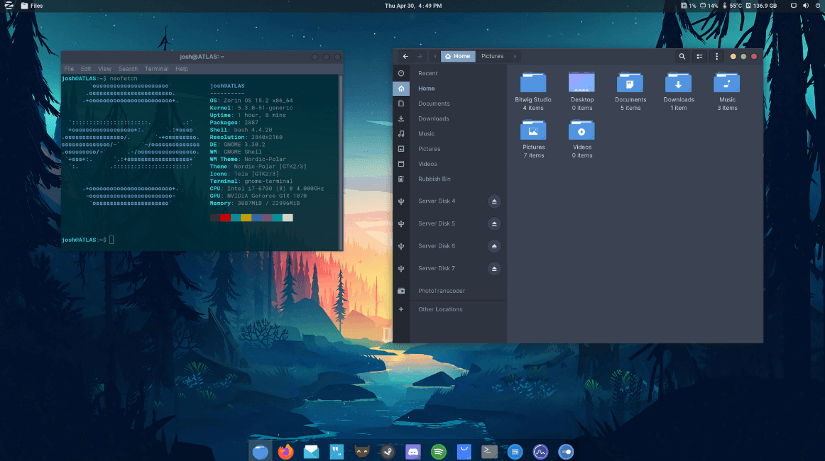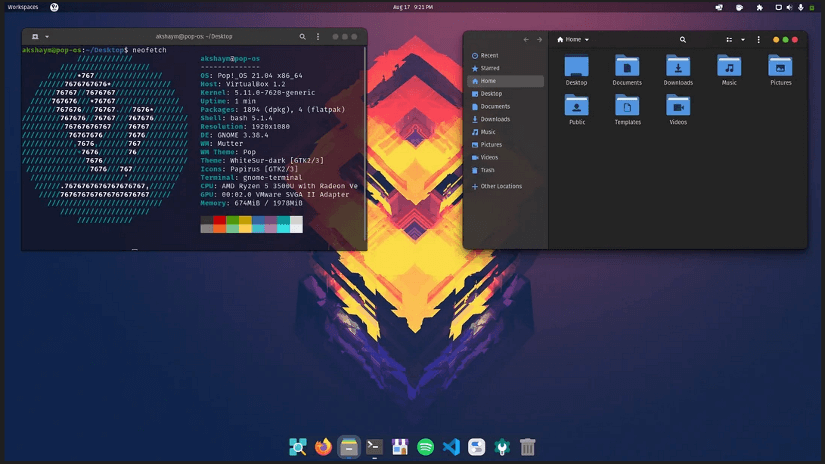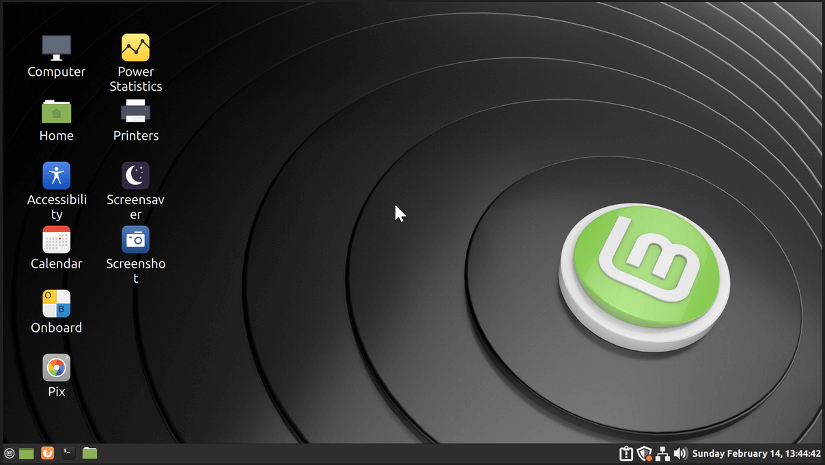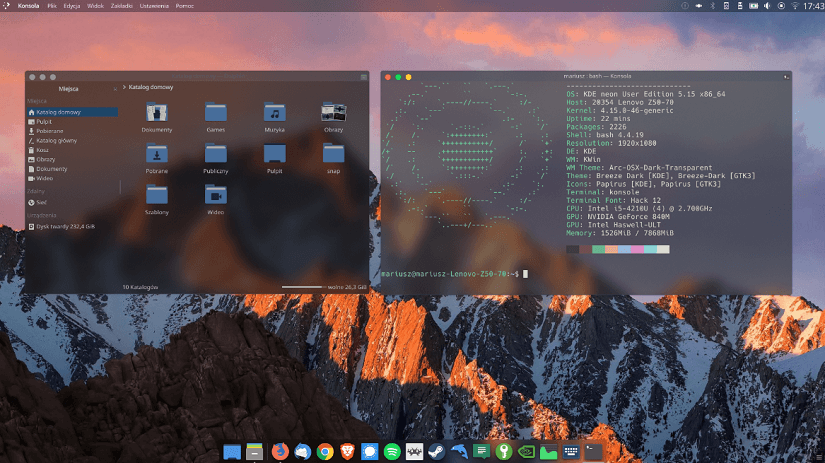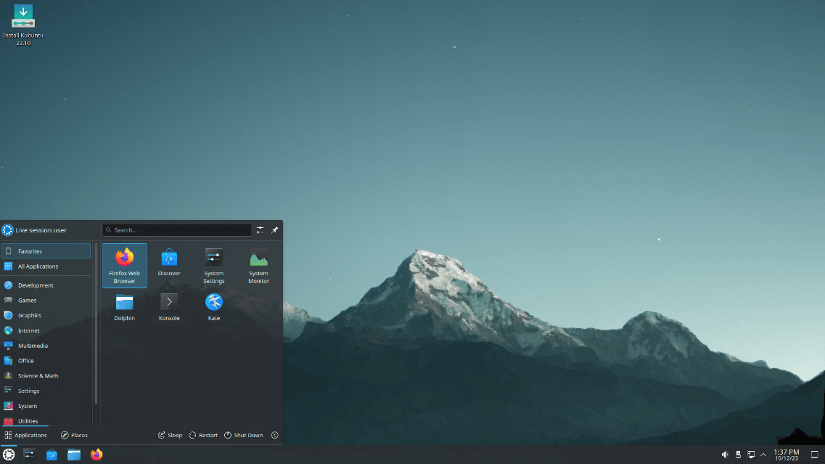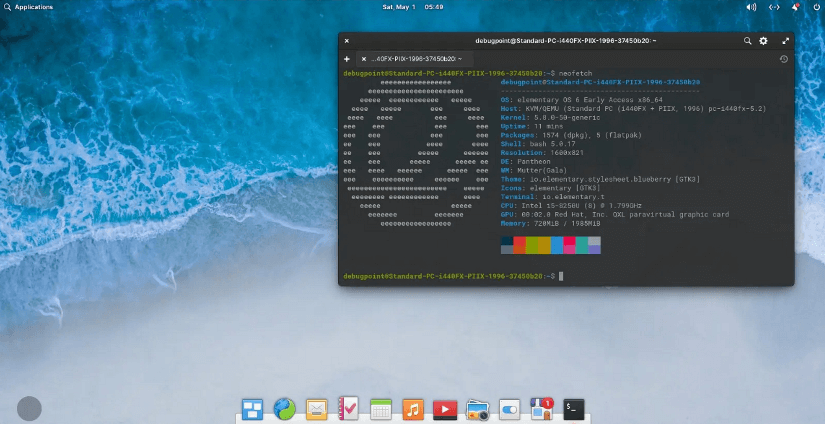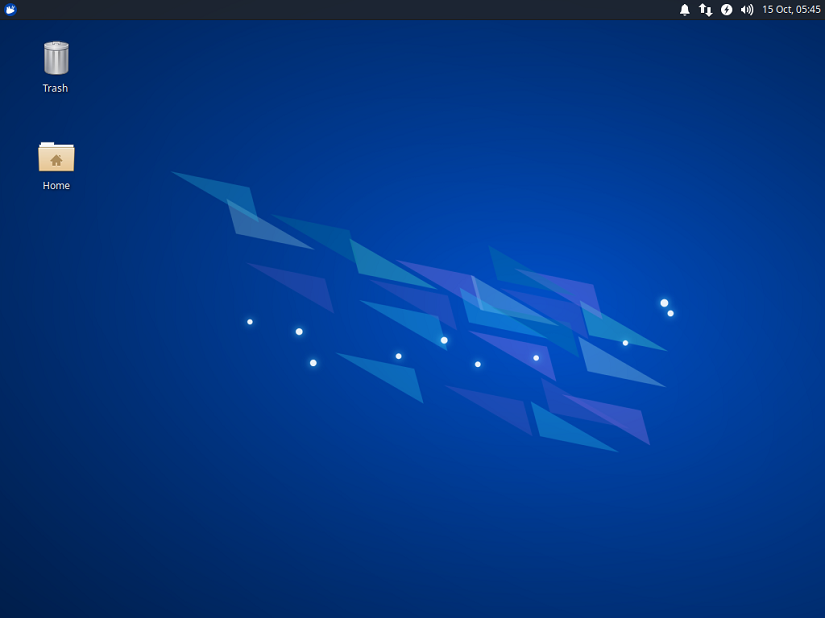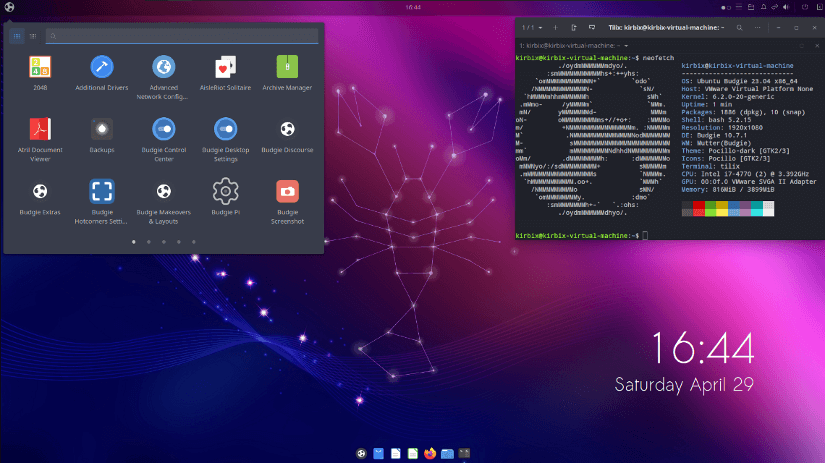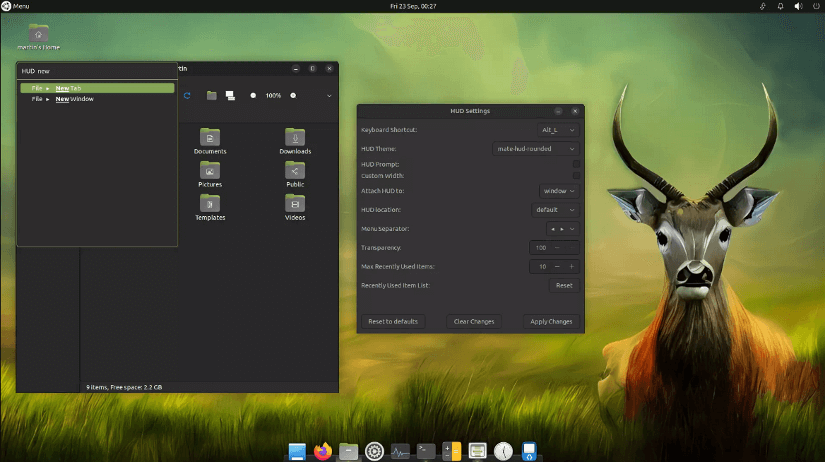FUNDAMENTALS A Complete Guide for Beginners

The top 10 best Ubuntu-based Linux distros as of 2024 are as follows:
- Zorin OS
- Pop!_OS
- Linux Mint
- KDE Neon
- Kubuntu
- Elementary OS
- Lubuntu
- Xubuntu
- Ubuntu Budgie
- Ubuntu Mate
Choosing the right Linux distribution is crucial for a fulfilling computing experience. With the abundance of Ubuntu-based distributions available, selecting the best one can be overwhelming. This writing aims to simplify the process by providing the top 10 Linux distro overviews along with a comparison to help you find the perfect Ubuntu-based Linux distribution for your needs.
1. Zorin OS
Zorin OS is an easy, lightweight Ubuntu-based Linux Distribution with a Windows-like user interface. It has several editions including a Lite version for older hardware, a Core version with basic features & a Pro version with additional software & customization options. Moreover, it has an education edition that is specifically designed for use in schools and other educational institutions. The latest release is Zorin OS 17.
Download Zorin OS
Click here to visit Zorin OS’s official download page.
System Requirements of Zorin OS
- 1GHz Single Core-Intel/AMD 64-bit processor.
- 1 GB RAM.
- 10GB (Core), 24GB (Education), or 40GB (Pro) of free hard disk storage space.
- 1024×768 resolution display.
Key Features of Zorin OS
- Zorin OS includes a built-in tool called “Zorin Appearance” that allows users to easily customize the look of their desktop. This tool offers a range of pre-installed themes, icons, and fonts. Moreover, it gives the option to download additional themes from the internet.
- Uses a customized version of the GNOME desktop environment, which includes a range of visual enhancements including a start menu, a taskbar, and a system tray with notification & system settings.
- Comes with a customizable user interface that resembles Windows, making it an easy transition for users switching from Windows.
- Has a large software repository of over 60,000 packages for installation. Moreover, it includes Wine, a compatibility layer that allows some Windows applications to run on Linux.
- Has relatively low system requirements.
2. Pop!_OS
Pop!_OS is a Linux distribution based on Ubuntu that is developed by System76, a company that produces Linux-powered computers. The GNOME desktop with a minimalist interface and various custom themes, icons, and wallpapers has made Pop!_OS one of the best-looking Linux distros.
Download Pop!_OS
Click here to visit Pop!_OS’s official download page.
System Requirements of Pop!_OS
- CPU 64-bit x86, ARM (RAS PI 4) architectures.
- RAM of 4GB, (recommended 8GB).
- 20GB free hard disk space.
Key Features of Pop!_OS
- Optimized for System76 hardware, with drivers and tools that are designed specifically for Sytem76
- Includes support for Flatpak, which allows users to install and manage a wide range of applications easily.
- Pop Shell, a tiling window manager provides a more efficient way to manage windows and applications.
- Due to its preinstalled NVIDIA drivers and tools, Pop!_OS provides built-in support for gaming.
3. Linux Mint
Linux Mint is a perfect Ubuntu-based distro for beginners due to its Windows-like familiar interfaces. Moreover, it performs great with older hardware and gained improvements over Ubuntu over time. The popular Linux Mint edition is the Linux Mint Cinnamon. The latest release is Linux Mint 21.3 Virginia.
Download Linux Mint
Click here to visit Linux Mint‘s official download page.
System Requirements of Linux Mint
- 2GB of RAM (4GB recommended).
- 20GB of free disk space.
- Display of 1024×768 resolution.
- Dual-core CPU.
Key Features of Linux Mint
- Linux Mint is an excellent choice for beginners as it’s known for its simplicity and ease of use.
- Available with a choice of desktop environments, including Cinnamon, MATE, and Xfce.
- Includes a range of multimedia codecs and plugins, making it possible to play a wide range of audio & video formats.
- Light on system resources with great stability.
- Has a larger user & developer community.
- Has a wide range of tools & utility applications.
4. KDE Neon
KDE Plasma is an elegant-looking desktop environment. The KDE Neon is often considered to be one of the best-looking Linux distros because of its use of the Breeze icon theme that gives the system a polished & unified look.
Download KDE Neon
Click here to visit KDE Neon’s official download page.
System Requirements of KDE Neon
- 64-bit PC (Intel or AMD).
- Minimum 2GB memory.
- Minimum 10GB disk space.
Key Features of KDE Neon
- Features the KDE Plasma desktop environment that provides a visually attractive & highly customizable interface.
- By default, it uses the Breeze theme to provide a clean and modern look.
- Includes a variety of desktop effects, such as smooth animations, window transparency, and interactive elements.
- Offers a selection of high-quality icons & widgets to provide a visually appealing experience.
5. Kubuntu
Kubuntu is a user-friendly Linux operating system that combines visual attractiveness with powerful features. It’s based on Ubuntu to ensure stability, and it utilizes the customizable KDE Plasma desktop to provide a personalized user experience. With its extensive multitasking capabilities and support for a wide range of applications, Kubuntu is suitable for both beginners and experienced users.
Download Kubuntu
Click here to visit Kubuntu’s official download page.
System requirements of Kubuntu
- 2 GHz dual-core processor.
- 4 GB RAM (system memory).
- 25 GB of hard drive space (or USB stick, memory card, or external drive but see LiveCD for an alternative approach).
- VGA capable of 1024×768 screen resolution.
- Either a CD/DVD drive or a USB port for the installer media.
Key Features of Kubuntu
- Kubuntu uses the visually appealing and customizable KDE Plasma desktop environment.
- Comes with a comprehensive set of default applications for productivity, graphics, and more.
- The default file manager, Dolphin, offers split view and terminal integration.
- Kubuntu plays most music and video formats out of the box.
- Firefox is the default web browser.
- Kubuntu includes the Konversation IRC client.
- Okular is the universal document viewer.
6. Elementary OS
It is a popular Linux distribution that aims to provide a user-friendly, fast, visually appealing operating system for desktops and laptops. As an Ubuntu-based Linux distro, it’s fully customizable. The latest release is Elementary OS 7.1.
Download Elementary OS
Click here to visit Elementary OS’s official download page.
System Requirements of Elementary OS
- Recent Intel i3 or comparable dual-core 64-bit processor.
- 4 GB of system memory (RAM).
- Solid state drive (SSD) with at least 32 GB of free space.
- 1024×768 minimum resolution display.
- You will also need a spare USB flash drive with at least 4 GB of storage for installation.
Key Features of Elementary OS
- Uses a range of subtle animations and effects to enhance users’ experience with elegance.
- Pantheon desktop environment, a clean & intuitive interface that includes a dock, a customizable sidebar, and a search for finding things.
- A centralized app store AppCentre makes it easy to download & install new applications.
- Includes app firewall, privacy mode to disable tracking, & a tool for encrypting files.
- Freya & Loki are two major releases of Elementary OS, where Freya was released in 2015 based on Ubuntu 14.04 & Loki in 2016, based on Ubuntu 16.04.
7. Lubuntu
One of the key features of Ubuntu’s flavor, Lubuntu, is its lightweight design, which makes it ideal for older or low-specification hardware. It requires minimal system resources and can run smoothly on computers with as little as 512 MB of RAM. Moreover, it includes a range of pre-installed software applications & uses minimal power.
Download Lubuntu
Click here to visit Lubuntu’s official download page.
System Requirements of Lubuntu
- Processor x86 with a clock speed of at least 1GHz.
- 512 MB (1GB is recommended) RAM.
- 5GB of free hard disk storage space.
Key Features of Lubuntu
- Lightweight, easy to use, & fast.
- Familiar interface for Windows users.
- Optimized for low-end hardware.
- Features the advanced LXQt desktop interface, utilizing Qt technologies.
- The combination of Arc theme and Papirus icons makes the new Lubuntu desktop easier to read and less cluttered.
- Provides access to thousands of free and secure applications via the Software Center.
- Supports various file formats.
8. Xubuntu
It is one of the flavors of Ubuntu that uses Xfce as its default desktop environment. Xfce makes sure that the experience is clutter-free & the distro is easy to use. Moreover, rolling updates ensure security & fix bugs. It runs better on comparatively modern PCs.
Download Xubuntu
Click here to visit Xubuntu’s official download page.
System Requirements of Xubuntu
- 5 GHz Dual Core Processor.
- 2GB of memory at least. Anyway, it can run on as low as 512 MB of RAM.
- 8GB of free space.
Key Features of Xubuntu
- Comes with Xfce, which is a stable, light, and configurable desktop environment.
- Provides a modern look and enough features for efficient, daily usage.
- Easy to use & optimized for low-end hardware.
- Familiar interface for Windows users.
- The latest version, Xubuntu 23.10 “Mantic Minotaur”, was released in October 2023.
- The latest version has improved hardware support for Bluetooth headphones and touchpads.
- Color emoji is now included and supported in Firefox, Thunderbird, and newer Gtk-based apps.
- Improved Screensaver Integration and Stability.
9. Ubuntu Budgie
Ubuntu Budgie, formerly known as budgie-remix, is an Ubuntu-derived operating system that features the Budgie desktop environment. It was initially created by the Solus project. This distro is known for its simplicity and elegance, aiming to produce a traditional desktop-oriented distro with a modern paradigm. It’s a great choice if you’re looking for a smooth and polished desktop environment.
Download Ubuntu Budgie
Click here to visit Ubuntu Budgie’s official download page.
System requirements of Ubuntu Budgie
Regular release 23.10
- 4GB or more of RAM.
- 64-bit capable Intel and AMD processors.
- UEFI PCs booting in CSM mode.
- Modern Intel-based Apple Macs.
LTS Release 22.04.3
- 4GB or more of RAM.
- 64-bit capable Intel and AMD processors.
- UEFI PCs booting in CSM mode.
- Modern Intel-based Apple Macs.
Key Features of Ubuntu Budgie
- Utilizes the Budgie desktop environment, known for its sleek design and user-friendly interface.
- New stylish menu applet and Budgie-based network manager applet as default.
- New window shuffler for easy window arrangement, activated by pressing Super+S or clicking on the window management icon.
- Due to community demand, files (Nautilus) have been replaced with Files (Nemo).
- Features a panel at the bottom of the screen for quick access to applications, workspaces, and system settings.
- Based on the latest Ubuntu LTS release, it includes popular applications like Firefox, LibreOffice, and Thunderbird.
- Available in both 32-bit and 64-bit versions to cater to a wide range of users.
- Additional features include Raven for notifications and Budgie Settings for centralized system settings.
10. Ubuntu Mate
Ubuntu MATE is a free, open-source Linux distribution that is based on Ubuntu and uses the MATE as the desktop environment. It is designed to run smoothly on older or low-specification hardware, making it a great choice for older laptops.
Download Ubuntu Mate
Click here to visit Ubuntu MATE’s official download page.
System Requirements of Ubuntu Mate
- Core 2 Duo (Recommended Corei3) Processor.
- 1GB (Recommended 4GB) RAM.
- Storage of 8 GB (Recommended 16GB).
- Display 1024×768 (Recommended 1440×900 or higher).
Key Features of Ubuntu Mate
- Simplicity of GNOME 2 with the power of Ubuntu.
- Works great on old laptops.
- Based on the latest Ubuntu LTS release, ensuring stability and long-term support.
- Customization options available for personalizing the desktop’s appearance.
- Access to a vast software repository and pre-installed applications like Firefox and LibreOffice.
- Unique features include the MATE Tweak Tool and MATE Menu for desktop customization.
- Integration with Ubuntu’s infrastructure provides access to documentation and support channels.
- Available in multiple desktop editions with different environments pre-installed.
- Active community offering support and contributing to the project.
Comparison Among Best Ubuntu Based Linux Distros
To view the comparative overview of the above-discussed best Ubuntu-based distros, please go through the following table:
| Name | Key Features | Desktop Environment | Latest Release |
|---|---|---|---|
| Zorin OS | Zorin Appearance, Windows/macOS-like UI | Xfce (Lite),
GNOME (Core), KDE (Pro) |
Zorin OS 17 |
| Pop!_OS | Pop Shell tiling window manager | GNOME
(Cosmic) |
Pop!_OS 23.10 |
| Linux Mint | User-friendly interface, stability | Cinnamon
(default), MATE, Xfce |
Linux Mint 21.3 “Virginia” |
| KDE Neon | Rolling release, latest KDE software | KDE Plasma | User Edition
Based on Plasma 5.30 |
| Kubuntu | An official Ubuntu flavor that has Ubuntu LTS base | KDE Plasma | Kubuntu 23.10 “Mantic Minotaur” |
| Elementary OS | Known for its clean, user-friendly interface that resembles macOS. | Pantheon | Elementary OS 7.1 |
| Lubuntu | Lightweight, balance of performance | LXQt | Lubuntu 23.10 “Mantic Minotaur” |
| Xubuntu | Lightweight, customizable | Xfce | Xubuntu 23.10 “Mantic Minotaur” |
| Ubuntu Budgie | Modern interface, productivity-focused | Budgie | Ubuntu Budgie 23.10 |
| Ubuntu Mate | An official Ubuntu flavor that provides a MATE desktop environment. | MATE | Ubuntu MATE 23.10 “Mantic Minotaur” |
Conclusion
To sum up, When choosing among these discussed Ubuntu-based distros, consider your preferences regarding the desktop environment, system performance, software availability, and user experience. Each distro serves different user needs and preferences, so it’s essential to evaluate them based on your specific requirements.
People Also Ask
What factors to consider while choosing best Ubuntu-based distro?
Here are some factors to consider when choosing an Ubuntu-based distro:
- Your needs and preferences: What are you going to use the distro for? Do you need a powerful gaming distro, a lightweight distro for an older computer, or a user-friendly distro for beginners?
- Your experience level: How comfortable are you with Linux? If you are a beginner, you may want to choose a distro that is easy to use and has good documentation.
- Hardware compatibility: Make sure the distro you choose is compatible with your hardware. You can check the distro’s website for system requirements.
- Software availability: Make sure the distro you choose has the software you need. You can check the distro’s software repository or package manager.
How many distros are based on Ubuntu?
There are 60+ active Ubuntu-based distros, even though the exact number is challenging to mention as there exist many unofficial modifications of Ubuntu. This abundance makes it difficult to track all of them accurately. Some of the well-known ones include Zorin OS, Pop!_OS, Linux Mint, KDE Neon, Kubuntu, Elementary OS, Lubuntu, Xubuntu, Ubuntu Budgie, and Ubuntu Mate, among others.
Which is better PoP OS or Ubuntu?
Pop!_OS offers a modern, customizable desktop experience with the COSMIC interface, newer kernel versions, and preinstalled Nvidia drivers for gaming. In contrast, Ubuntu remains a reliable, widely used distribution with its standard GNOME interface and support for Canonical’s Snap format.
Which is the best Ubuntu version?
Some of the best Ubuntu versions include Pop!_OS, a popular choice for gamers due to its focus on performance and integration with graphics drivers. Ubuntu itself is a good all-rounder with a wide range of software available for general use. Lightweight Lubuntu and Xubuntu are great options for older computers or those who prefer a minimalist experience. Zorin OS and Elementary OS are known for their beginner-friendly interfaces and easy installation whilst Kubuntu and Ubuntu Budgie offer extensive desktop customization options.
